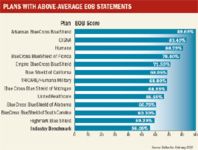Maximize messaging in EOB statements
A recent national sampling of 34 insurers' EOBs by DALBAR, a third-party communications evaluation firm, gave 68% of the EOB statements it analyzed a failing grade.

"The majority of them really fail to answer the basic questions for members: 'How much, if anything, do I owe?' 'What action should I take?' and 'What is my financial obligation?'" says Kathleen Whalen, DALBAR's managing director. "They all have the basic requirements in there, but the language that is typically used in the EOBs that are not performing well is so obfuscating that it's very confusing."
Boston-based DALBAR also evaluates account statements in financial services market research. This report marks its first foray into the healthcare arena. The analysis is far from comprehensive because it evaluates EOBs and Medicaid's Summary Notice from just 33 organizations-a fraction of the nation's many health plans. However, it provides a window into how well plans are communicating with members.
What it determined was that only three insurers earned an "excellent" mark in terms of clarity, content and design of their EOBs, and less than a third earned a rating of "good" or better. Only three firms include any charts or graphics on their EOBs to help members visualize how their benefits work, and most included jargon-filled supplemental notes placed far away from the information to which they apply.
That's a costly oversight, according to the DALBAR report. Confusing EOBs negatively impact customer satisfaction and result in otherwise avoidable phone calls to busy customer service departments. Furthermore, "it's a missed opportunity."
Rather than treating EOBs as a necessary evil, Whalen says plans should use them as an opportunity to foster member loyalty and share personally relevant health information.
"They should really be leveraging these documents," she says. "Here is something everybody opens. They should be asking themselves how they can maximize it."
Jim Dougherty, director of the healthcare practice at J.D. Power & Associates, says that forward-looking plans are using the statements as an opportunity to link members with health information derived from claims data.
The new generation EOB is "much more personal than a newsletter with another article saying 'eat your broccoli and exercise,'" he says.
Dougherty notes that Humana and CIGNA, plans whose EOBs scored well on the DALBAR study, have focused on providing personalized messages and eliminating jargon. Other plans are working on delivering their EOBs electronically, which is much faster and cheaper than regular mail.
MEMBERS OFTEN CONFUSED
All these strategies are useful, Dougherty says, because EOBs are an important ingredient for overall customer satisfaction. According to J.D. Power's fourth annual health plan member satisfaction survey, released in April, only 40% of the 34,000 respondents representing 133 different plans said they fully understand what is included in their benefits packages. Improved communications can go a long way toward eliminating that confusion and promoting satisfaction.
Better EOBs aren't the silver bullet, he says, "but because they're used frequently by beneficiaries, they're an important step."
-Shelly Reese
Conversations With Perry and Friends
April 14th 2025Perry Cohen, Pharm.D., a longtime member of the Managed Healthcare Executive editorial advisory board, is host of the Conversations with Perry and Friends podcast. His guest this episode is John Baackes, the former CEO of L.A. Care Health Plan.
Listen
Ohio’s Medicaid Work Requirement Efforts Aim to Boost Engagement, Avoid Coverage Loss
April 18th 2025Maureen Corcoran, director of the Ohio Department of Medicaid, believes the work requirement policy can be both a financial and moral effort to improve the lives of Medicaid consumers.
Read More
Breaking Down Health Plans, HSAs, AI With Paul Fronstin of EBRI
November 19th 2024Featured in this latest episode of Tuning In to the C-Suite podcast is Paul Fronstin, director of health benefits research at EBRI, who shed light on the evolving landscape of health benefits with editors of Managed Healthcare Executive.
Listen
Why Better Data and Awareness Matters for Medicaid Work Requirements
April 17th 2025With policymakers considering work requirements for Medicaid eligibility, Jennifer Haley, principal research associate in the Health Policy Division at the Urban Institute, said it’s more important than ever to understand how those changes could unintentionally cause harm, particularly when data systems fall short and public awareness is limited.
Read More